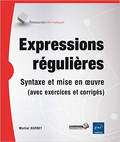GNU/Linux man pages
Livre :
Expressions régulières,
Syntaxe et mise en oeuvre :


GNU/Linux |
CentOS 4.8 |
i386 |
 |
ilaenv(l) |
 |
ILAENV - i called from the LAPACK routines to choose problem-dependent parameters for the local environment
|
INTEGER FUNCTION |
ILAENV( ISPEC, NAME, OPTS, N1, N2, N3, N4 ) | ||
|
CHARACTER*( |
* ) NAME, OPTS | ||
|
INTEGER |
ISPEC, N1, N2, N3, N4 |
ILAENV is called from the LAPACK routines to choose problem-dependent parameters for the local environment. See ISPEC for a description of the parameters.
This version provides a set of parameters which should give good, but not optimal, performance on many of the currently available computers. Users are encouraged to modify this subroutine to set the tuning parameters for their particular machine using the option and problem size information in the arguments.
This routine will not function correctly if it is converted to all lower case. Converting it to all upper case is allowed.
ISPEC (input) INTEGER
Specifies the parameter to be
returned as the value of ILAENV. = 1: the optimal blocksize;
if this value is 1, an unblocked algorithm will give the
best performance. = 2: the minimum block size for which the
block routine should be used; if the usable block size is
less than this value, an unblocked routine should be used. =
3: the crossover point (in a block routine, for N less than
this value, an unblocked routine should be used) = 4: the
number of shifts, used in the nonsymmetric eigenvalue
routines = 5: the minimum column dimension for blocking to
be used; rectangular blocks must have dimension at least k
by m, where k is given by ILAENV(2,...) and m by
ILAENV(5,...) = 6: the crossover point for the SVD (when
reducing an m by n matrix to bidiagonal form, if
max(m,n)/min(m,n) exceeds this value, a QR factorization is
used first to reduce the matrix to a triangular form.) = 7:
the number of processors
= 8: the crossover point for the multishift QR and QZ
methods for nonsymmetric eigenvalue problems. = 9: maximum
size of the subproblems at the bottom of the computation
tree in the divide-and-conquer algorithm (used by xGELSD and
xGESDD) =10: ieee NaN arithmetic can be trusted not to trap
=11: infinity arithmetic can be trusted not to trap
NAME (input) CHARACTER*(*)
The name of the calling subroutine, in either upper case or lower case.
OPTS (input) CHARACTER*(*)
The character options to the subroutine NAME, concatenated into a single character string. For example, UPLO = ’U’, TRANS = ’T’, and DIAG = ’N’ for a triangular routine would be specified as OPTS = ’UTN’.
N1 (input) INTEGER
N2 (input) INTEGER N3 (input) INTEGER N4 (input) INTEGER Problem dimensions for the subroutine NAME; these may not all be required.
>= 0: the value of the parameter specified by ISPEC < 0: if ILAENV = -k, the k-th argument had an illegal value.
The following
conventions have been used when calling ILAENV from the
LAPACK routines:
1) OPTS is a concatenation of all of the character options
to
subroutine NAME, in the same order that they appear in the
argument list for NAME, even if they are not used in
determining
the value of the parameter specified by ISPEC.
2) The problem dimensions N1, N2, N3, N4 are specified in
the order
that they appear in the argument list for NAME. N1 is used
first, N2 second, and so on, and unused problem dimensions
are
passed a value of -1.
3) The parameter value returned by ILAENV is checked for
validity in
the calling subroutine. For example, ILAENV is used to
retrieve
the optimal blocksize for STRTRI as follows:
NB = ILAENV( 1,
’STRTRI’, UPLO // DIAG, N, -1, -1, -1 )
IF( NB.LE.1 ) NB = MAX( 1, N )
 |
ilaenv(l) |  |